Disabled Village Children
A guide for community health workers,
rehabilitation workers, and families
By David Werner
with the help of many friends Drawings by the author
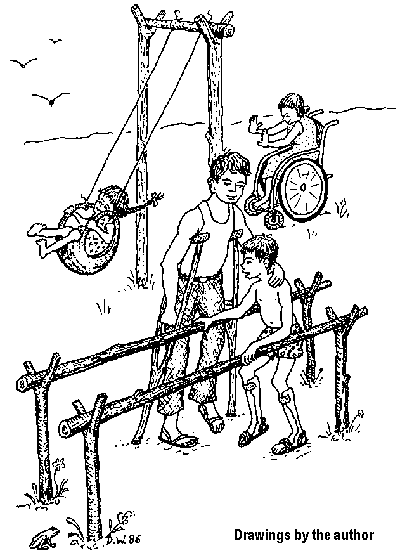
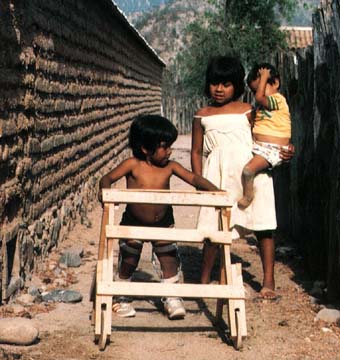
HOW TO USE THIS BOOK
This is a reference book to help you meet the needs of disabled children. You need not read it from cover to cover. Use it to look up particular information as you need it.
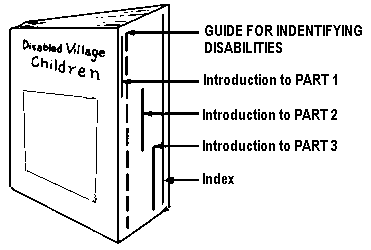
To learn how the book is organized, and why, we suggest you read ABOUT THIS BOOK at the beginning. Also, please read the introduction to each of the 3 main parts of the book. These chapters have page edges with a short black line, to help you find the beginning of PARTS 1, 2, and 3.
To work more effectively with disabled children, we strongly suggest that you read the first 5 chapters of PART 1. These will help you to examine a child, to identify different disabilities, and to keep important records in an easy way.
THERE ARE SEVERAL WAYS TO FIND INFORMATION THAT YOU ARE LOOKING FOR:
-
Check the list of CONTENTS at the beginning of the book. This tells you what each chapter is about and gives the page numbers.
-
Look in the INDEX at the end of the book. It lists topics in alphabetical order. (The edges of these pages are all black.)
-
If you do not know what disability a child has, use the GUIDE FOR IDENTIFYING DISABILITIES on Page52 to 58. It lists the common signs of different disabilities and gives the page numbers. (There are several black lines on the edges of these pages.)
Throughout the book you will find this symbol ![]() in the margin of some pages. It appears where there is information for cerebral palsy.
in the margin of some pages. It appears where there is information for cerebral palsy.
If you want more information than is in this book, see the list of books and teaching materials entitled REFERENCES (Where to Get More Information), Page 637.
If you do not know what some words mean, look in the LIST OF SPECIAL OR DIFFICULT WORDS, Page 643. Words explained in this LIST are written in italics when first used in a chapter.
IMPORTANT: To find all the information you will need for one disabled child, you will usually need to look in several different chapters. To know where to look, follow the page references shown. These are explained inside the back cover.
* Asterisk: This little star is called an asterisk. It is used to indicate that there is more information about a word or an idea at the bottom of the page.
 For more information on how to use this book, see the inside of the back cover.
For more information on how to use this book, see the inside of the back cover.
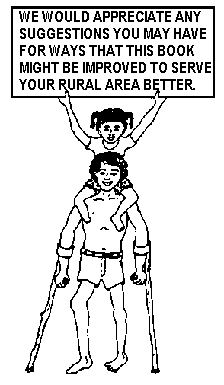
This book is dedicated to disabled children everywhere,
with the hope that they and their families
will help lead the world
to be more loving, understanding,
and just for everyone.
REQUEST FOR YOUR SUGGESTIONS, CRITICISMS, AND IDEAS
This book is an attempt to pull together basic information to help you meet the needs of village children with a wide range of disabilities.
We have done the best we can, given our limitations. We know the book is not perfect and that it has weaknesses and perhaps some mistakes.
We urge anyone reviewing or using the book, whether a disabled person, parent, health worker, or professional, to send us all your criticism and suggestions. Help us to make improvements for a later edition. Thank you.
CONTENTS
ABOUT THIS BOOK
PART 1. WORKING WITH THE CHILD AND FAMILY:
Information on Different Disabilities
- Chapter 1.Introduction to PART 1: Making Therapy Functional and Fun
A. Where Do We Start?
- Chapter 2. Ideas for Sharing Information from This Book
- Chapter 3. Prevention of Disabilities
- Chapter 4. Examining and Evaluating the Disabled Child
- Chapter 5. Simple Ways to Measure and Record a Child's Progress
B. Recognizing, Helping with, and Preventing Common Disabilities
- Chapter 6. Guide For Identifying Disabilities
- Chapter 7. Polio
- Chapter 8. Contractures: Limbs That No Longer Straighten
- Chapter 9. Cerebral Palsy (difficulty with movements because of brain damage)
- Chapter 10. Muscular Dystrophy: Gradual, Progressive Muscle Loss
- Chapter 11. Club Feet, Flat Feet, Bow Legs, and Knock-knees
- Chapter 12. Common Birth Defects (cleft lip, extra or joined fingers, incomplete l and arthrogryposis)
- Chapter 13. Children Who Stay Small or Have Weak Bones (includes Rickets, Brittle Bone Disease, and Dwarfism)
- Chapter 14. Erb's Palsy: Arm Paralysis from Birth Injury
- Chapter 15. Painful Joints (includes How to Use Aspirin)
- Chapter 16. Juvenile Arthritis
- Chapter 17. Rheumatic Fever
- Chapter 18. Hip Problems
- Chapter 19. Bone Infections
- Chapter 20. Spinal Curve and Other Back Deformities
- Chapter 21. Tuberculosis of the Backbone - Pott's Disease
- Chapter 22. Spina Bifida (babies born with a defect over their backbone)
- Chapter 23. Spinal Cord Injury
- Chapter 24. Pressure Sores
- Chapter 25. Urine and Bowel Management: With Spinal Cord Injury and Spina Bifida (includes Urinary Infections)
- Chapter 26. Leprosy
- Chapter 27. Amputations
- Chapter 28. Burns and Burn Deformities
- Chapter 29. Fits: Epilepsy
- Chapter 30. Blindness and Difficulty Seeing
- Chapter 31. Deafness and Communication
- Chapter 32. Mental Retardation: Down Syndrome, Cretinism, and Other Causes
- Chapter 33. The Child with Several Severe Disabilities
C. Helping the Child Whose Mind and/or Body are Slow to Develop
- Chapter 34. Child Development and Developmental Delay
- Chapter 35. Early Stimulation and Development Activities
D. Helping Children Develop and Become More Self-reliant
- Chapter 36. Feeding
- Chapter 37. Dressing
- Chapter 38. Toilet Training
- Chapter 39. Bathing (includes Care of the Teeth and Gums)
- Chapter 40. Ways to Improve Learning and Behavior
- Chapter 41. 'Learning Disabilities' in Children with Normal Intelligence
E. Exercises and Techniques
- Chapter 42. Range-of-motion and Other Exercises
- Chapter 43. Crutch Use, Cane Use, and Wheelchair Transfers
PART 2. WORKING WITH THE COMMUNITY:
Village Involvement in the Rehabilitation, Social Integration, and Rights of Disabled Children
- Chapter 44.Introduction to PART 2: Disabled Children in the Community
- Chapter 45. Starting Village-based Rehabilitation Activities
- Chapter 46. Playgrounds for All Children
- Chapter 47. CHILD-to-child: Helping Teachers and Children Understand Disabled Children
- Chapter 48. Popular Theater
- Chapter 49. A Children's Workshop for Making Toys
- Chapter 50. Organization, Management, and Financing of a Village Rehabilitation Program
- Chapter 51. Adapting the Home and Community to the Needs of the Disabled
- Chapter 52. Love, Sex, and Social Adjustment
- Chapter 53. Education: At Home, at School, at Work
- Chapter 54. Work: Possibilities and Training
- Chapter 55. Examples of Community-Directed Programs
PART 3. WORKING IN THE SHOP:
Rehabilitation Aids and Procedures
- Chapter 56.Introduction to PART 3: Making Sure Aids and Procedures Do More Good than Harm
- Chapter 57. A 'Shop for Making Aids' Run by Disabled Villagers
- Chapter 58. Braces (Calipers)
- Chapter 59. Correcting Joint Contractures (with casts or braces)
- Chapter 60. Correcting Club Feet (with tape or plaster casts)
- Chapter 61. Homemade Casting Materials
- Chapter 62. Developmental Aids (for lying, sitting, standing, balance, and communication)
- Chapter 63. Walking Aids (bars, crutches, walkers, canes)
- Chapter 64. Decisions about Special Seats and Wheelchairs
- Chapter 65. Adaptations for Wheelchairs and Other Sitting Aids
- Chapter 66. Designs for 6 Basic Wheelchairs
- Chapter 67. Artificial Legs
REFERENCE (Where To Get More Information)
LIST OF SPECIAL OR DIFFICULT WORDS Used In This Book
INDEX

THANKS
This book has been a cooperative effort. Many persons have contributed in different ways. Some have helped to write or rewrite different sections. Some have criticized early drafts; Some have used it in their programs and sent us feedback; Some have sent original ideas or technologies that we have tested and then included. In all, persons or programs from 27 countries on 6 continents (North and South America, Africa, Asia, Europe, Australia) have contributed.
The entire book has been carefully reviewed by specialists in related fields: physical therapists (PTs), occupational therapists (OTs), orthotists, prosthetists, wheelchair designers, rehabilitation engineers, and leaders from among the disabled. We cannot include the names of all those who have helped in so many ways, but the help of the following has been outstanding:
Sophie Levitt, PT; Ann Hallum, PT; Terry Nordstrom, PT; Anne Affleck, OT; Mike Miles, rehab planner and critic; Christine Miles, special educator; Farhat Rashid, PT; Bruce Curtis, peer disabled group counselor; Ralf Hotchkiss, wheelchair rider/engineer; Alice Hadley, PT; Jan Postma, PT; Jean-Baptiste Richardier, prosthetist; Claude Simonnot, MD/prosthetist; Wayne Hampton, MD/prosthetist; Jim Breakey, prosthetist; Wally Motlock, orthotist; Valery Taylor, PT; Dr. P. K. Sethi, orthopedic surgeon/prosthetist; Pam Zinkin, pediatrician/CBR expert; Paul Silva, wheelchair builder; David Morley, pediatrician; Elia Landeros, PT; Teresa paez, social worker; Rafiq Jaffer, rehab specialist; Kris Buckner, parent of many adopted disabled children; Barbara Anderson, PT; Don Caston, rehab engineer; Greg Dixon, Director, Partners' Appropriate Technology In Health; Susan Hammerman, Director, Rehabilitation International; Carole Coleman, specialist in sign language; Suzanne Reier, recreation therapist; Sarah Grossman, PT; Donald Laub, plastic surgeon; Jean Kohn, MD in rehabilitation; Bob Friedricks, orthotist; Katherine Myers, spinal cord injury nurse; Grace Warren, PT in leprosy; Jean M. Watson, PT in leprosy; David Sanders, pediatrician; Jane Neville, leprosy expert; Stanley Browne, MD, leprosy; Alexandra Enders, OT; John McGill, prosthetist; Victoria Sheffield, Rita Leavell, MD, Jeff Watson, J. Kirk Horton, Lawrence Campbell, Helen Keller International; Owen Wrigley, IHAP; Roswitha and Kenneth Klee, Winfried Lichtemberger, Jeanne R. Kenmore, Christoffel Blindenmission; Judy Deutsch, PT; Jane Thiboutot, PT; R. L. Huckstep, MD; Linda Goode, PT; Susan Johnson, PT; David Hall, child health consultant; Ann Goerdt, PT for WHO; Mira Shiva, MD; Nigel Shapcott, seating specialist; Ann Yeadon, educator; Charles Reilly, sign language consultant; Eli Savanack, Gallaudet College; John Gray, MD; Molly Thorburn, MD; Lonny Shavelson, MD; Margaret Mackenzie, medical anthropologist; Rainer Arnhold, MD; Gulbadan Habibi, Caroline Arnold, Philip Kgosana, Garren Lumpkin, UNICEF.
Above all, We would like to thank the team of disabled village rehabilitation workers in Project PROJIMO, Ajoya, Sinaloa, Mexico, along with the hundreds of disabled children and their families. Their involvement and interaction in exploring, testing, inventing, and discovering simplified alternatives has led to the formation of this book. Key among the PROJIMO team are: Marcelo Acevedo, Miguel Alvarez, Adelina Bastidas, Roberto Fajardo, Teresa Garate, Bruce Hobson, Concepcion Lara, Ines Leon, Ramon Leon, Polo Leyva, Armando Nevarez, Maria Picos, Adelina Pliego, Elijio Reyes, Cecilia Rodriguez, Josefa Rodriguez, Concepcion Rubio, Moises Salas, Rosa Salcido, Asuncion Soto, Javier Valverde, Florentino Velazquez, Efrain Zamora, Miguel Zamora.
For this book we have borrowed information, ideas, illustrations, methods, and designs from many sources, published and unpublished. Often credit has been given, but not always. If you notice we have 'borrowed' from your material and neglected to give you credit, please accept our unspoken thanks and apologies.
For their excellent and dedicated work in preparing the manuscript for publication, special thanks go to: Jane Maxwell, editing, page design, and art production; Irene Yen, editing and paste-up; Kathy Alberts, Elizabeth de Avila, Martin Bustos, Mary Klein, Carlos Romero and Marjorie Wang, paste-up; Martin Bustos and Anna Munoz-Briggs. Spanish translation; Myra Polinger, typing; Lynn Gordon, Bill Bower, Phil Pasmanick and Dan Periman, general review; Alison Davis, reference section research; Elizabeth de Avila, Don Baker, Agnes Batteiger, Jane Bavelas, Leda Bosworth, Renee Burgard, Michael Lang, Betty Page, Pearl Snyder, Tinker Spar, Paula Tanous and Roger Wilson, proofreading; Lino Montebon, Joan Thompson and David Werner, drawings; Richard Parker, John Fago, Carolyn Watson, Tom Wells and David Werner, photography; Dyanne Ladine, art production; Martin Bustos and Richard Parker, photo production; Hal Lockwood and Helen Epperson of Bookman Productions, Tim Anderson and Linda Inman of Reprographex, typesetting and layout; and Trude Bock for giving so wholeheartedly of herself and her home for the preparation of this book.
We want to give an extra word of thanks to Carol Thuman for coordination, typing, and correspondence and Janet Elliott for graphics, artwork, and paste-up, and to both for sharing the responsibility for the preparation and quality of this book.
The main costs of preparing this book were met by grants from the Public Welfare Foundation, whose continued friendship and support of the Hesperian Foundation's new publications is deeply appreciated. Additional funding was generously provided by the Gary Wang Memorial Fund, UNICEF, OXFAM UK, the Swedish International Development Agency, and MISEREOR. We would also like to thank the Thrasher Research Fund and Mulago Foundation for helping meet the costs of Project PROJIMO, from which this book evolved.
For this third printing, we would like to thank Manisha Aryal for coordination; Martin Bustos for meticulous research; Susan McCallister for copy editing and careful proofreading; and Elena Metcalf for page layout and proofreading.
Finally, we would like to thank David Werner for his careful and hard work in preparing this book. His vision and advocacy for disabled people around the world is reflected throughout the book.

This book is divided into 3 parts.
PART 1: WORKING WITH THE CHILD AND FAMILY (Chapters 1 to 42)
This is the longest part of the book, divided into 5 sections:
- Section A (Chapters 2 to 5): ideas for sharing information from the book; and background information on working with disabled children
- Section B (Chapters 6 to 33): detailed information on specific disabilities
- Section C (Chapters 34and 35): on the child who is slow to learn and to develop
- Section D (Chapters 36 to 41): on helping disabled children become more self-reliant
- Section E (Chapters 42 and 43): on learning specific exercises; includes techniques for using crutches, canes, and wheelchairs
PART 2: WORKING WITH THE COMMUNITY (Chapters 44 to 55)
- ideas for starting a community program, and for helping the community respond to the needs of disabled children
PART 3: WORKING IN THE SHOP (Chapters 56 to 67)
- suggestions for setting up a workshop and for making aids, wheelchairs, braces, and rehabilitation equipment
LOOKING UP PAGE REFERENCES
Usually the chapter that discusses a specific disability will not include all the information necessary to meet a child's needs. You will also have to look in other chapters. There are several ways to find out where to look.
-
As you read a chapter, often you will come to page references such as "(See Page 471)." This means that you can turn to page 471 for more information on the topic being discussed.
-
To find all the different places in the book that give important information about a specific disability or topic, use the INDEX.
-
In some chapters, where further reading is essential, there is a list of references to other parts of the book at the end of the chapter. (See, for example, Page 75.)
It is very important that you learn how to look up these references, and do so. If you do not, the information to meet a child's needs will not be complete.
| REMEMBER: The best way to learn how to use this book is to work for a while with the guidance of experienced rehabilitation workers. |
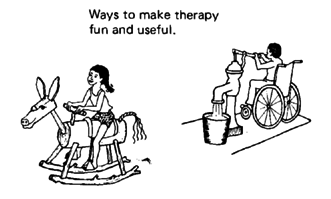
|
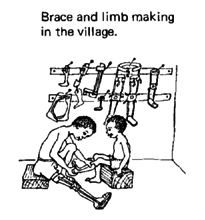
|
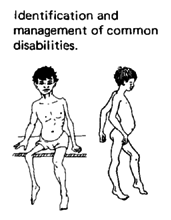
|
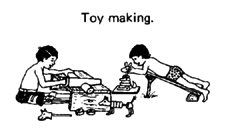
|
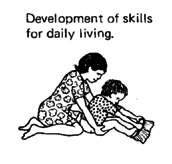
|

|
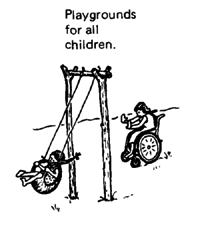
|
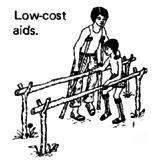
|
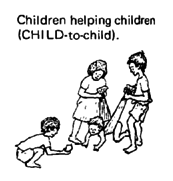
|
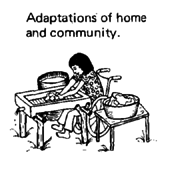
|
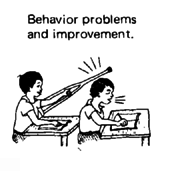
|
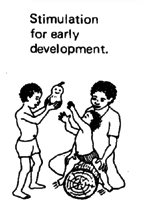
|
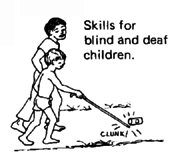
|
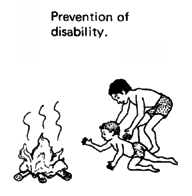
|
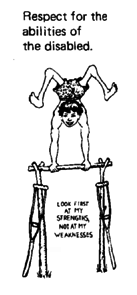
|
Homemade wheelchairs and wheel boards. |
Disabled Village Children is a book of information and ideas for all who are concerned about the well - being of disabled children. It is especially for those who live in rural areas where resources are limited. But it is also for therapists and professionals who assist community-based programs or who want to share knowledge and skills with families and concerned members of the community.
Written by David Werner with the help of disabled persons and pioneers in rehabilitation in many countries, this book has been prepared in a style and spirit similar to the author's earlier works, Where There Is No Doctor and Helping Health Workers Learn. It gives a wealth of clear, simple, but detailed information concerning most common disabilities of children: many different physical disabilities, blindness, deafness, fits, behavior problems, and developmental delay. It gives suggestions for simplified rehabilitation, low-cost aids, and ways to' help disabled children find a role and be accepted in the community.
Above all, the book helps us to realize that most of the answers for meeting these children's needs can be found within the community, the family, and in the children themselves. It discusses ways of starting small community rehabilitation centers and workshops run by disabled persons or the families of disabled children.
Over 4,000 line drawings and 200, photos help make the information clear even to those with little formal education.
Library of Congress Cataloging in Publication Data
Includes Index
1. Medicine, Popular - Handbooks, manuals, etc.
2. Rehabilitation - Handbooks, manuals, etc.
3. Community Health Aids - Handbooks, manuals, etc.
Catalog Card No.: 86-81738
Werner, David, 1943 -
Disabled Village Children
Palo Alto, CA: Hesperian Foundation
672 p.
ISBN: 0-942364-06-6
PUBLISHED BY:
The Hesperian Foundation
P.O. Box 11577
Berkeley, CA 94712-2577
Copyright c 1987 by the Hesperian Foundation
2nd edition, 5th printing February 1999
The Hesperian Foundation encourages others to copy, reproduce or adapt to meet local needs, any or all parts of this book, including the illustrations, provided the parts reproduced are distributed free or at cost-not for profit.
Any organization or person who wishes to copy, reproduce, or adapt, any or all parts of this book for commercial purposes, must first obtain permission to do so from the Hesperian Foundation.
Please contact the Hesperian Foundation before beginning any translation or adaptation to avoid duplication of efforts, and for suggestions about adapting the information in this book. The Foundation would appreciate receiving a copy of any materials in which text or illustrations from this book have been used.
